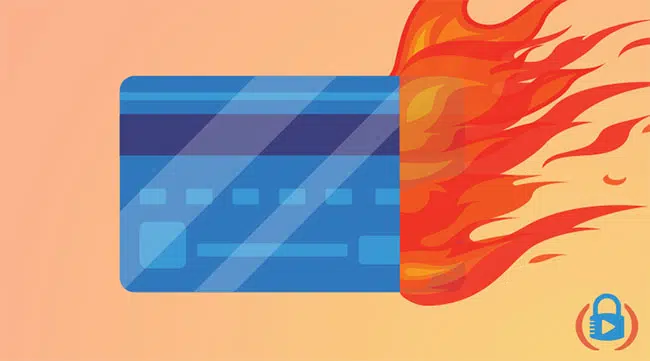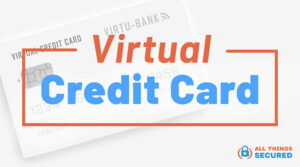A one-time use credit card is a credit card number that can be used once and only for a limited time. It’s commonly used as an alternative to traditional credit cards when making online payments, especially when shopping online. It provides better financial security and privacy for users. A select number of banks offer this kind of credit card, in which you generate a one-time credit card number for security.

A single-use credit card is a type of virtual card that allows online shoppers to mask their real bank or credit card information. The card relies on a uniquely generated card number, expiration date, and security code as a proxy.
One-time use cards may be connected to a traditional account as a free add-on for improved security. Because they are virtual credit card numbers, you can create as you want without affecting your credit score or account standing.
There are a number of benefits of a one-time-use card that are worth understanding.
What is a One-Time Use Credit Card?
A one-time use credit card is a type of virtual credit card designed for enhanced security during online transactions. Unlike traditional credit cards, which can be used multiple times, a one-time use credit card is generated for a single transaction or a limited period.
This means your actual credit card details remain private, significantly reducing the risk of fraud. These virtual credit cards are typically generated through banking apps or websites and can be used for various online purchases, in-app transactions, shopping online, and other digital payments.
Benefits of a One-Time-Use Card
Traditional physical credit cards come with many potential risks, and the benefit of a one-time use credit card often mitigates these risks. Unlike a physical card, a one-time use credit card offers enhanced security and convenience. One of the primary benefits of a one-time use credit card is the enhanced security it offers when shopping online. For example:
- The Risk of Theft is Low: If someone steals your physical credit card, they may make hundreds (or even thousands) of dollars worth of purchases before you can cancel the card. While you’ll usually be able to get the money back due to fraud, it is still concerning. A one-time use credit card minimizes this risk by allowing you to limit spending on the card and close it after one use.
- They are Easy to Replace: While physical credit cards take weeks to replace, which can be incredibly inconvenient, you can easily create new virtual credit cards in minutes.
- They Don’t Affect Your Credit Score: Another major downfall of physical cards is that opening and closing credit cards affects your credit score. On the other hand, virtual credit cards do not impact your credit score at all.
- They Can be Merchant-Specific: There are a number of consumer virtual credit card providers that allow you to automatically create a new one-time-use card when checking out with a merchant online. By doing this, you can ensure the credit card is only good for the purchase amount, which means it cannot be stolen. The information you enter is only good for a limited time and doesn’t show up anywhere permanent.
- They Offer INCREDIBLE Control: You can set your own limits with a one-time-use card, including a monthly, yearly, per transaction, or total spending limit. You do not have to limit the card to one-time use, but you can.
Getting a one-time use credit card is far easier than you may imagine!
You do not need another credit card company to get one. Instead, you can either log into your bank if they offer this service (each bank is different) or create one within 10 minutes on Privacy.com (limited to US-residents only).
Here’s a breakdown of the simple steps to create a one-time-use credit card.
How to Get a One-Time Use Credit Card (Traditional Bank)
Many traditional banks and credit card issuers are beginning to offer virtual credit cards to their existing customers. Getting a one-time use credit card is a straightforward process that can be completed online or through a mobile app. Here’s a step-by-step guide to help you get started:
- Check with Your Credit Card Issuer: Not all credit card issuers offer one-time use credit cards, so it’s essential to check with your bank or credit card company. Look for information on their website or contact customer service to confirm availability.
- Log in to Your Online Account or Mobile App: If your issuer provides one-time use credit cards, you’ll typically find the option to generate a virtual credit card number in your online account or mobile app. Navigate to the relevant section to get started.
- Select the Type of Transaction or Merchant: Some issuers may require you to specify the type of transaction or merchant you want to use the virtual credit card for. This step helps tailor the virtual card to your specific needs.
- Generate the Virtual Credit Card Number: Once you’ve selected the type of transaction or merchant, your issuer will generate a virtual credit card number, expiration date, and security code. This information will be used for your online purchases.
- Use the Virtual Credit Card Number: You can now use the virtual credit card number to make a purchase online or over the phone. The transaction will be processed as usual, but the merchant will only receive the virtual credit card number, not your actual credit card details.
How to Create a Virtual One-Time Credit Card
Of course, not every bank allows for this type of one-time use credit card, so the alternative that is available to everybody is what is known as a virtual credit card.
Step 1: Create a Privacy.com Account
First, head to Privacy.com to create your account. This should only take a few minutes. You’ll need to enter your basic personal and contact information such as:
- Legal name
- Birthday
- Phone number
- Email address
- Contact information
- Checking account for electronic transfers
To make an account, you must meet the following criteria:
- US resident
- 18+
- Can verify your identity (for example, with an ID number)
Add a Funding Source to Your Account
Once you have your account set up, you must select your “Funding Source.” You can choose your debit card or bank account as a funding source.
Since you cannot use a traditional credit card as a funding source, you may not be able to earn “points” or conventional credit card rewards. You must have the money in the bank to make each purchase with the Privacy.com one-time-use card.
This means that you will not be able to build up a bunch of credit card debt with your one-time-use cards. Your credit card payments will only go through when you have enough money in the bank to fund them.
Create Your First Virtual Credit Card
After you enter your funding source, it’s time to create your credit cards!
You can create your credit cards on Privacy.com at any time. You can have the credit card number expire after the first use, or hold onto it for several months and use it for recurring expenses. You can also set spending limits based on how you plan to use the card.
If you use 1Password as your password manager, you can create Privacy credit cards on the fly for your online purchases. Here’s how:
- Head to your Profile
- Go to “Accounts”
- Turn on the 1Password integration
- Connect your Privacy and 1Password accounts
- Create new cards at any time from the 1Password extension
Get the Expiration Date and Security Code
Once you get the expiration date and security code generated, you can use the virtual card information the same way you’d use your physical credit card info when making purchases online.
And if they are one-time use cards, that means that the moment they are used for the amount you have set, they will automatically close.
Virtual Credit Card Numbers vs. Physical Credit Cards
Virtual credit card numbers and physical credit cards both serve the purpose of facilitating transactions, but they operate differently.
- A physical credit card is a traditional card with a tangible presence, featuring a card number, expiration date, and security code. In contrast…
- A virtual credit card numbers are digital and are generated through banking apps or websites. These virtual cards can be used for online transactions and are often designed for single-use or a limited timeframe.
This digital nature of virtual credit cards provides an extra layer of security, as the actual card details are never exposed during the transaction.
Common Uses of One-Time Use Credit Cards
One-time use credit cards are incredibly versatile and can be used for a variety of online transactions, especially when shopping online. They are perfect for online shopping, allowing you to make purchases without exposing your actual credit card details.
You can also use them to:
- Pay bills;
- Make in-app purchases;
- Subscribe to streaming platforms;
- Create software subscriptions;
Additionally, one-time use credit cards are ideal for online travel bookings, such as flights, hotels, or rental cars, providing an extra layer of security for your travel plans.
Integrating One-Time Use Credit Cards with Your Financial Systems
Integrating one-time use credit cards with your financial systems can help streamline your transactions and improve your overall financial management. Here are some ways to integrate one-time use credit cards with your financial systems:
- Accounting Software: Integrate your one-time use credit cards with accounting software like QuickBooks or Xero. This allows you to track transactions automatically, making it easier to manage your finances and generate reports.
- Budgeting Apps: Use budgeting apps such as Mint or YNAB to link your one-time use credit cards. This helps you monitor your spending in real-time and stay within your budget, ensuring you have better control over your finances.
- Digital Wallets: Add your one-time use credit cards to digital wallets like Apple Pay or Google Wallet. This integration makes it convenient to make purchases online or in-store while keeping your actual credit card details secure.
- Online Banking: Link your one-time use credit cards with your online banking platform. This allows you to manage your transactions, monitor account activity, and ensure that your spending aligns with your financial goals.
By integrating one-time use credit cards with these financial systems, you can enhance your financial management and enjoy a more seamless and secure transaction experience.
Virtual Credit Cards and Digital Wallets
Virtual credit cards and digital wallets are two popular payment methods that offer convenience and security. Here’s a comparison of the two:
- Virtual Credit Cards: Virtual credit cards are digital representations of your physical credit card. They can be used to make purchases online or over the phone, providing an additional layer of security by keeping your actual credit card details private. These cards are ideal for online transactions, offering a temporary card number that can be used for a single purchase or a limited period.
- Digital Wallets: Digital wallets, such as Apple Pay or Google Wallet, allow you to store your credit card information on your mobile device. You can use your digital wallet to make purchases online or in-store, and it offers an additional layer of security by using tokenization to protect your credit card information. Digital wallets are versatile, supporting both online and in-person transactions.
- Key Differences: The key difference between virtual credit cards and digital wallets is their primary use case. Virtual credit cards are typically used for online transactions, providing a secure way to shop without exposing your actual card details. In contrast, digital wallets can be used for both online and in-store transactions, offering a convenient and secure way to pay using your mobile device.
Understanding the unique benefits of virtual credit cards and digital wallets can help you choose the best payment method for your needs, ensuring your transactions are both convenient and secure.
Requirements for Using a One-Time Use Credit Card
To use a one-time use credit card, you’ll typically need to meet the following requirements:
- Existing Credit Card Account: You’ll need to have an existing credit card account with a bank or credit card issuer that offers one-time use credit cards. This is essential as the virtual card is linked to your existing account.
- Online Account or Mobile App: Access to your online account or mobile app is necessary to generate a virtual credit card number. Ensure you have the login credentials and know how to navigate the platform.
- Bank Account: You’ll need to have a bank account linked to your credit card account to fund your transactions. This ensures that your virtual credit card is backed by a reliable source of funds.
- Age and Residency: Typically, you need to be at least 18 years old and a resident of the United States to use a one-time use credit card. These requirements may vary depending on the issuer, so it’s best to check with your bank or credit card company.
Meeting these requirements ensures that you can take full advantage of the security and convenience offered by one-time use credit cards.
Managing One-Time Use Credit Cards
Managing one-time use credit cards requires some planning and organization. Here are some tips to help you manage your one-time use credit cards:
- Keep Track of Your Virtual Credit Card Numbers: Make sure to keep track of your virtual credit card numbers, expiration dates, and security codes. This helps you stay organized and ensures you have the necessary information when making purchases.
- Set Spending Limits: You can set spending limits on your one-time use credit cards to control your spending and avoid overspending. This feature allows you to define a maximum amount for each transaction, helping you stay within your budget.
- Monitor Your Account Activity: Regularly monitor your account activity to detect any suspicious transactions or activity. Keeping an eye on your transactions helps you quickly identify and address any potential issues.
- Cancel or Close Cards: If you no longer need a one-time use credit card, make sure to cancel or close it to avoid any unauthorized transactions. This ensures that your virtual credit card numbers are not misused.
By following these tips, you can effectively manage your one-time use credit cards, ensuring your online transactions are secure and your finances are well-organized.
Best Practices for Using One-Time Use Credit Cards
To maximize the benefits of one-time use credit cards and ensure your online transactions are secure, follow these best practices:
- Generate a New Card for Each Transaction: Always create a new one-time use credit card number for every transaction to minimize the risk of fraud.
- Set Spending Limits: Establish spending limits for each one-time use credit card to prevent overspending and maintain control over your finances.
- Use a Secure Internet Connection: Ensure you are on a secure internet connection when generating and using one-time use credit cards to protect your information.
- Keep Your Account Information Private: Safeguard your virtual credit card account details to prevent unauthorized access.
- Monitor Account Activity: Regularly check your account activity to quickly detect and address any suspicious transactions.
By adhering to these best practices, you can enjoy the convenience and security of one-time use credit cards while minimizing the risks associated with online transactions.
Who Should Get a One-Time-Use Credit Card?
A single-use credit card is valuable to anyone who shops online. They will help you protect your personally identifiable information and control your finances.
You can get as many virtual card numbers as you want, to use for one-time payments or recurring payments with set limits. You’ll often also get to decide how long the virtual credit card number is valid. If you don’t get to decide, the expiration date will be generated for you.
Protect yourself against potential credit card fraud with virtual credit cards. Overall, the peace of mind that comes with one-time-use credit cards is worth it.



